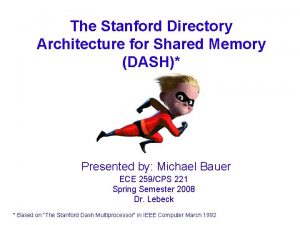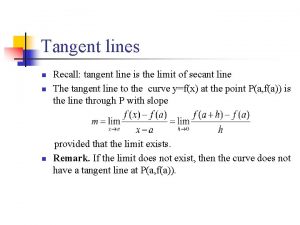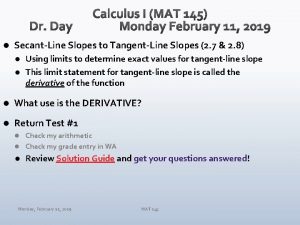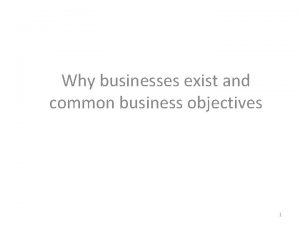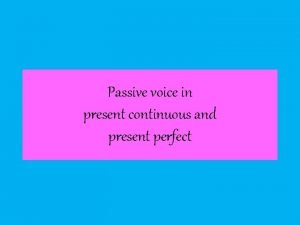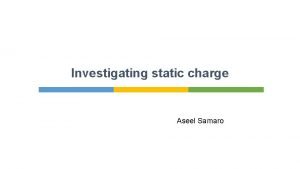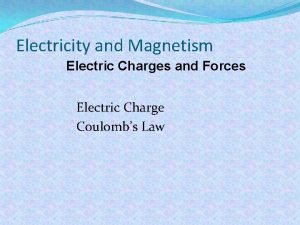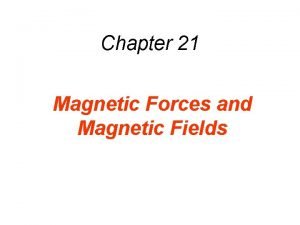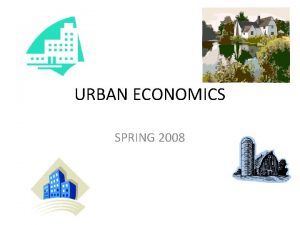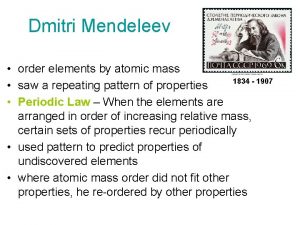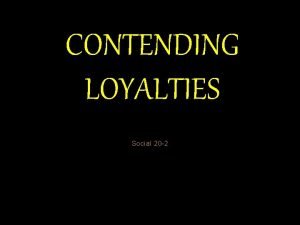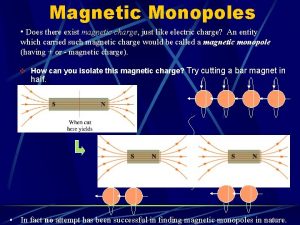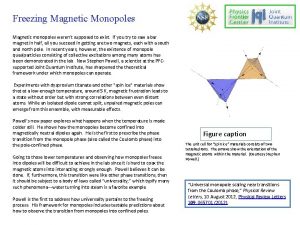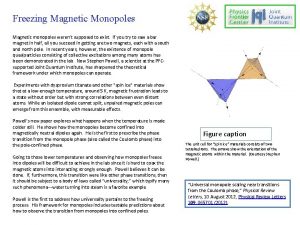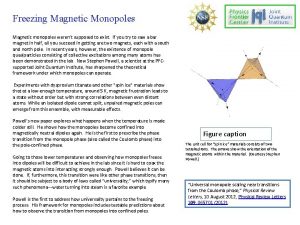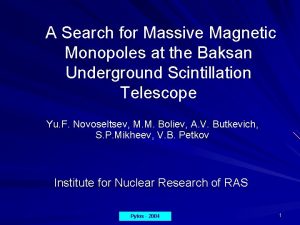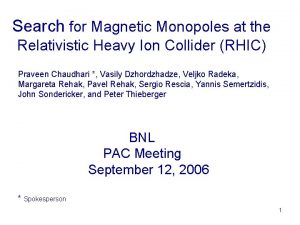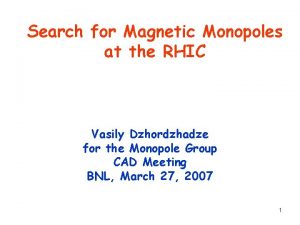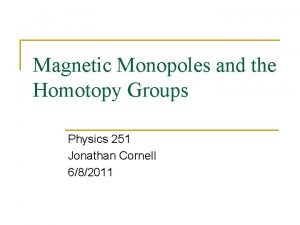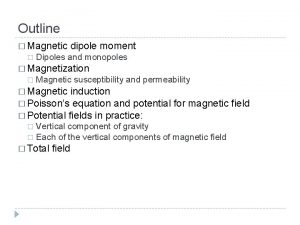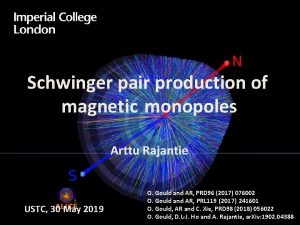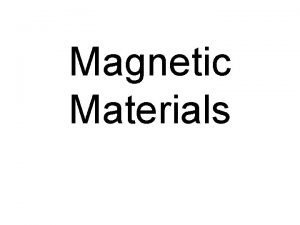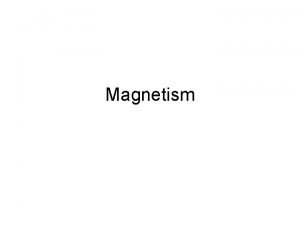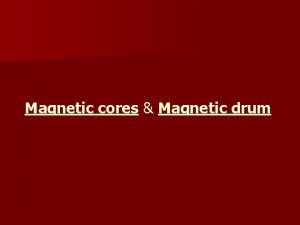Lecture 14 1 Magnetic Monopoles Does there exist






















- Slides: 22

Lecture 14 -1 Magnetic Monopoles • Does there exist magnetic charge, just like electric charge? An entity which carried such magnetic charge would be called a magnetic monopole (having + or - magnetic charge). • How can you isolate this magnetic charge? Try cutting a bar magnet in half. • In fact no attempt has been successful in finding magnetic monopoles in nature.

Lecture 14 -2 READING QUIZ 1 The Hall effect is the action of a magnetic field B on the carriers of a current I = EL/R in a solid rectangular sample with area A = length L x width w. A magnetic field is perpendicular to the area A and the current I = EL/R flows parallel to the length L. Which of the following statements is incorrect. A| The Hall voltage depends on the drift velocity of the charged carriers. B| The Hall voltage depends on the length L of the solid sample. C| The Hall voltage depends on the magnitude of the magnetic field. D| The Hall voltage depends on the width w of the sample.

Lecture 14 -3 Magnetic Field B • Magnetic force acting on a moving charge q depends on q, v. Vary q and v in the presence of a given magnetic field and measure magnetic force F on the charge. Find: F varies sinusoidally as direction of v is changed (q>0) direction by Right Hand Rule. B is a vector field This defines B. 1 T = 104 gauss (earth magnetic field at surface is about 0. 5 gauss) If q<0

Lecture 14 -4 Magnetic Force on a Current • Consider a current-carrying wire in the presence of a magnetic field B. • There will be a force on each of the charges moving in the wire. What will be the total force d. F on a length dl of the wire? • Suppose current is made up of n charges/volume each carrying charge q < 0 and moving with velocity v through a wire of cross-section A. • Force on each charge = • Total force = • Current = For a straight length of wire L carrying a current I, the force on it is: A

Lecture 14 -5 Cyclotron • "Magnetic Resonance Accelerator" • "Dees" in constant magnetic field B • Alternating voltage V is applied between the Dees at the orbital frequency f: • Particle will acquire an additional kinetic energy q. V each time it crosses the gap (ie twice per revolution. . E=0 in Dees!). increases as v does Problems synchrotron http: //www. kgv. net/amorrison/assets/animations/cyclotron. swf

Lecture 14 -6 DOCCAM 2 FORCE BETWEEN TWO WIRES 6 B 10

Lecture 14 -7 Synchrotron r is the same since B increases as v does

Lecture 14 -8 More complicated situations? v is not perpendicular to B Also non-uniform B magnetic bottle helical motion (spiral) electron in magnetic field Van Allen belts

Lecture 14 -9 Polar Light High energy particles leaked out of the belt and interact with the earth atmosphere.

Lecture 14 -10 Warm-up quiz 2 An electron (charge -e) comes horizontally into a region of perpendicularly crossed, uniform E and B fields as shown. In this region, it deflects upward as shown. What can you do to change the path so it remains horizontal through the region? a) b) c) d) e) Increase E Increase B Turn B off Turn E off Nothing http: //canu. ucalgary. ca/map/content/force/elcrmagn/simulate/magnetic/applet. html http: //canu. ucalgary. ca/map/content/force/elcrmagn/simulate/exb_thomson/applet. html

Lecture 14 -11 Magnetic Force on a Current Loop Force on closed loop current in uniform B? – Force on top path cancels force on bottom path (F = IBL) – Force on right path cancels force on left path. (F = IBL) closed loop Uniform B is exerts no net force on closed current loop.

Lecture 14 -12 Magnetic Torque on a Current Loop Definition of torque: abut a chosen point • If B field is parallel to plane of loop, the net torque on loop is 0. B • If B is not zero, there is net torque. magnetic moment direction so that n is twisted to align with B

Lecture 14 -13 DOCCAM 2 ELECTRIC MOTOR 6 B-12

Lecture 14 -14 Calculation of Torque • Suppose the coil has width b (the side we see) and length a (into the screen). The torque about the center is given by: area of loop • Define magnetic dipole moment by where n is normal to the loop with RHR along I.

Lecture 14 -15 Example of Magnetic Moment Calculation A thin non-conducting disk of mass m and uniform surface charge density σ rotates with angular velocity ω as shown. What is the magnetic moment? mag. moment of the ring shown: d. I

Lecture 14 -16 Potential Energy of Dipole • Work must be done to change the orientation of a dipole (current loop) in the presence of a magnetic field. • Define a potential energy U (with zero at position of max torque) corresponding to this work. q Þ Therefore, Þ B x Þ .

Lecture 14 -17 Potential Energy of Dipole Illustrated m B m x B B m x x t=0 t = m. B X t=0 U = -m. B U=0 U = m. B min. energy max torque negative work max. energy positive work (by YOU)

Lecture 14 -18 Hall Effect • A conducting strip in crossed E and B fields • Applied E along the strip leads to a charge buildup on the sides of the strip and thus an electric field EH develops perpendicular to both applied E and B. Ø Determines the sign and number of carriers. EH EH Ø Measures B.

Lecture 14 -19 Carrier Sign and Density from Hall Effect Sign and density of charge carrier is determined at equilibrium Hall voltage EH and EH for a given current I and n

Lecture 14 -20 10: 30 Quiz 3 October 6, 2011 An proton (charge +e) comes horizontally into a region of perpendicularly crossed, uniform E and B fields as shown. In this region, it is deflected upward as shown. What can you do to change the path so it deflects downward instead through the region? a. Increase E b. Turn B off c. Turn E off d. Slow down the electron e. None of the above

Lecture 14 -21 11: 30 – Quiz 3 October 6, 2011 A proton (charge +e) comes horizontally into a region of perpendicularly crossed, uniform E and B fields as shown. In this region, it goes straight without deflection. What can you do to change the path so it deflects upward through the region? a. Increase E b. Increase B c. Turn B off d. Slow down the proton e. None of the above

Lecture 14 -22 11: 30 Quiz 3 March 1, 2011 A proton (charge +e) comes horizontally into a region of perpendicularly crossed, uniform E and B fields as shown. In this region, it deflects downward as shown. What can you do to change the path so it remains horizontal through the region? a. Increase E b. Turn B off c. Turn E off d. Slow down the electron e. Increase B
 Maxwell's equations magnetic monopoles
Maxwell's equations magnetic monopoles Remanent magnetization
Remanent magnetization Unit of magnetic flux is weber
Unit of magnetic flux is weber Magnetic moment and magnetic field relation
Magnetic moment and magnetic field relation Force on charged particle
Force on charged particle 01:640:244 lecture notes - lecture 15: plat, idah, farad
01:640:244 lecture notes - lecture 15: plat, idah, farad Does dash still exist
Does dash still exist When derivative does not exist
When derivative does not exist Does magenta exist
Does magenta exist Where does derivative not exist
Where does derivative not exist How to find if a limit exists
How to find if a limit exists Why businesses exist
Why businesses exist Why does the development gap exist
Why does the development gap exist If you don't measure it you can't improve it
If you don't measure it you can't improve it Passive perfect continuous
Passive perfect continuous Does magnetic field exerts force on a static charge
Does magnetic field exerts force on a static charge Does magnetic field exerts force on a static charge
Does magnetic field exerts force on a static charge Does magnetic field exerts force on a static charge
Does magnetic field exerts force on a static charge Why do cities exist
Why do cities exist What continent did the vikings come from
What continent did the vikings come from Why do markets exist
Why do markets exist Which elements exist as diatomic molecules
Which elements exist as diatomic molecules Contending nationalist loyalties in canada
Contending nationalist loyalties in canada






